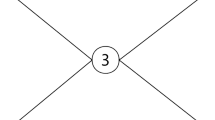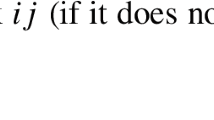Abstract
How do networks form and what is their ultimate topology? Most of the literature that addresses these questions assumes complete information: agents know in advance the value of linking even with agents they have never met and with whom they have had no previous interaction (direct or indirect). This paper addresses the same questions under the much more natural assumption of incomplete information: agents do not know in advance—but must learn—the value of linking. We show that incomplete information has profound implications for the formation process and the ultimate topology. Under complete information, the network topologies that form and are stable typically consist of agents of relatively high value only. Under incomplete information, a much wider collection of network topologies can emerge and be stable. Moreover, even with the same topology, the locations of agents can be very different: An agent can achieve a central position purely as the result of chance rather than as the result of merit. All of this can occur even in settings where agents eventually learn everything so that information, although initially incomplete, eventually becomes complete. The ultimate network topology depends significantly on the formation history, which is natural and true in practice, and incomplete information makes this phenomenon more prevalent.










Similar content being viewed by others
Notes
We emphasize that we study learning during the network formation process, rather than learning in an exogenously given and fixed network structure. For a study on the latter, see for example Acemoglu et al. (2011).
Indirect linking provides a positive externality when information is complete as well, but the effect is completely different: \(i,j\) know exactly the value of the (potential) link between them, so they will never form a link which either may regret forming.
A general measure space of types could be accommodated easily but with added technical complications.
As mentioned before, in generic cases, agent \(i\)’s best response will not depend on her own type. Nevertheless, we still keep the type of \(i\) as an argument in \(i\)’s strategy since it is part of \(i\)’s knowledge after all.
One such selection path is \(((1,2),(1,3),(2,6),(3,7),(6,7),(1,5),(5,9),(6,9),(1,4),(4,8),(7,8),(8,9),(8, 9),(2,5),(3,5),(4,5))\).
We set the “high-type” agent’s value to be \(f(x)=6\) and the “low-type” agent’s value to be \(f(x)=4\). In addition, we assume that \(c=5\) and \(\delta =0.6\). In each simulation, we let the formation process run for 2,500 periods. We use 100 simulations to find the average result.
Essentially, a tree network is equivalent to a minimally connected network, and a star network is a special case of a tree network.
In the simulation, we assume that the payoffs from a high-value, medium-value and low-value agent are \(15, 10\) and 4 respectively. We assume that \(c=5\) and \(\delta =0.6\). The probabilities for an agent to be of high-value, medium-value and low-value are \((1/3,1/3,1/3)\) for uniform distribution, \((4/7,2/7,1/7)\) for high-type environment, \((1/7,2/7,4/7)\) for low-type environment and \((1/7,4/7,2/7)\) for medium-type environment. In each simulation, we let the formation process run for 2,500 periods. We use 100 simulations to find the average difference.
We use the network that forms at the end of the simulation as a proxy for a stable network. In counting the number of networks, we keep the agents anonymous, i.e., they only differ by their types, so that the result reflects the number of distinct network topologies rather than the number of permutations.
References
Acemoglu, D., Dahleh, M.A., Lobel, I., Ozdaglar, A.: Bayesian learning in social networks. Rev. Econ. Stud. 78(4), 1201–1236 (2011)
Bala, V., Goyal, S.: A noncoorperative model of network formation. Econometrica 68(5), 1181–1229 (2000)
Ballester, C., Calvo-Armengol, A., Zenou, Y.: Who’s who in networks. Wanted: the key player. Econometrica 74(5), 1403–1417 (2006)
Barabasi, A.L., Albert, R.: Emergence of scaling in random networks. Science 286, 509–512 (1999)
Corbae, D., Duffy, J.: Experiments with network formation. Games Econ. Behav. 64(1), 81–120 (2008)
Dutta, B., Ghosal, S., Ray, D.: Farsighted network formation. J. Econ. Theory 122, 143–164 (2005)
Falk, A., Kosfeld, M.: It’s all about connections: evidence on network formation. CEPR Discussion Papers (3970) (2003)
Fricke, D., Finger, K., Lux, T.: On assortative and dissasortative mixing in scale-free networks: the case of interbank credit networks. Kiel Working Paper (1830) (2013)
Galeotti, A.: One-way flow networks: the role of heterogeneity. Econ. Theory 29(1), 163–179 (2006)
Galeotti, A., Goyal, S.: The law of the few. Am. Econ. Rev. 100(4), 1468–1492 (2010)
Galeotti, A., Goyal, S., Kamphorst, J.: Network formation with heterogeneous players. Games Econ. Behav. 54, 353–372 (2006)
Goeree, J.K., Riedl, A., Ule, A.: In search of stars: network formation among heterogeneous agents. Games Econ. Behav. 67(2), 455–466 (2009)
Haller, H., Sarangi, S.: Nash networks with heterogeneous agents. Discussion Papers of DIW Berlin (337) (2003)
Jackson, M.O., Watts, A.: The evolution of social and economic networks. J. Econ. Theory 106, 265–295 (2002)
Jackson, M.O., Wolinsky, A.: A strategic model of social and economic networks. J. Econ. Theory 71, 44–74 (1996)
Leung, M.: Two-step estimation of network-formation models with incomplete information. Working Paper (2013)
McBride, M.: Imperfect monitoring in communication networks. J. Econ. Theory 126, 97–119 (2006)
Mele, A.: A structural model of segregation in social networks. NET Institute Working Papers (10–16) (2010)
Rong, R., Houser, D.: Emergent star networks with ex ante homogeneous agents. GMU Working Paper in Economics (12–33) (2012)
Watts, A.: A dynamic model of network formation. Games Econ. Behav. 34, 331–341 (2001)
Zhang, Y., van der Schaar, M.: Information production and link formation in social computing systems. IEEE J. Sel. Areas Commun. 30(11), 2136–2145 (2012)
Zhang, Y., van der Schaar, M.: Strategic networks: Information dissemination and link formation among self-interested agents. IEEE J. Sel. Areas Commun. 31(6), 1115–1123 (2013)
Author information
Authors and Affiliations
Corresponding author
Additional information
We thank two anonymous referees for useful comments. We are also grateful to William Zame, Ichiro Obara, Moritz Meyer-ter-Vehn, Sanjeev Goyal, Simpson Zhang, Onur Atan and a number of seminar audiences for suggestions which have improved the paper. This work was supported by the National Science Foundation (NSF) under Grant CCF-1218136.
Rights and permissions
About this article
Cite this article
Song, Y., van der Schaar, M. Dynamic network formation with incomplete information. Econ Theory 59, 301–331 (2015). https://doi.org/10.1007/s00199-015-0858-y
Received:
Accepted:
Published:
Issue Date:
DOI: https://doi.org/10.1007/s00199-015-0858-y
Keywords
- Network formation
- Incomplete information
- Dynamic network formation
- Link formation
- Formation history
- Externalities




